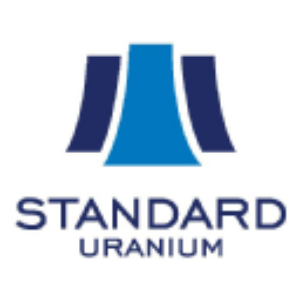Standard Uranium and Aero Energy Report New Gravity Survey Targets and Assay Results, Sun Dog Project, Northwest Athabasca Basin
Rhea-AI Summary
Standard Uranium (STTDF) and Aero Energy have completed a high-resolution ground gravity survey at the Sun Dog Project in Saskatchewan's Athabasca Basin. The survey identified several new priority drill targets across the Wishbone, McNie, and Armbruster South target areas. The 48,443-acre project, located 15 km Southeast of Uranium City, includes the historical Gunnar Uranium Mine which produced approximately 18M lbs of U3O8 between 1953-1981.
Results from the 2024 drill program confirmed uranium mineralization in all eight holes within the Wishbone target area, with drill hole SD-24-018 showing the highest uranium values of up to 176.0 ppm. The program, consisting of 1,593 metres of drilling, also revealed structurally-hosted dravitic clays and key uranium pathfinder elements.
The gravity surveys have identified density-low bullseye anomalies representing potential zones of hydrothermal alteration, leading to multiple new drill target zones being identified along these trends.Positive
- All eight drill holes from 2024 program showed uranium mineralization
- New gravity survey identified multiple promising drill targets
- Project includes historical Gunnar Mine which was once Canada's largest uranium producer
- Favorable geological environment confirmed for uranium deposition
- Strategic location in the Athabasca Basin near Uranium City
Negative
- Uranium mineralization levels are currently low-grade with highest value at 176.0 ppm (0.026% U3O8)
- Project still in early exploration phase with no resource estimates
- Further drilling required to determine economic viability
News Market Reaction 1 Alert
On the day this news was published, STTDF gained 2.50%, reflecting a moderate positive market reaction.
Data tracked by StockTitan Argus on the day of publication.
Additional Targets Emerging in Underexplored Rocks
Vancouver, British Columbia--(Newsfile Corp. - May 7, 2025) - Standard Uranium Ltd. (TSXV: STND) (OTCQB: STTDF) (FSE: 9SU0) ("Standard Uranium" or the "Company") is pleased to announce the completion of an extensive high-resolution ground gravity survey across three target areas on the Sun Dog Project ("Sun Dog", or the "Project"), northern Saskatchewan. Integration and analysis of geophysical data sets has generated several new priority drill targets across the Wishbone, McNie, and Armbruster South target areas. Additionally, analytical results from the 2024 drill program — designed to test the newly identified Wishbone target area — have returned anomalous uranium from all eight drill holes.
The Project is currently under a three-year earn-in option agreement (the "Option") with Aero Energy Ltd. (TSXV: AERO)("Aero") that was executed on October 20, 2023. The 2024 drill program was funded by Aero and operated by Standard Uranium. Sun Dog covers an area of 48,443 acres (19,604 ha) across nine mineral claims and is located 15 km Southeast of Uranium City on the northern margin of the Athabasca Basin (Figure 1). It hosts the historical Gunnar Uranium Mine, discovered in 1952, which doubled Canada's uranium production and became the largest uranium producer globally in 1956. The Gunnar Mine produced approximately 18M lbs of U3O8 between 1953 and 19811,2.
Highlights:
- Extensive Ground Gravity Survey: Ground gravity surveys have been completed over the Armbruster South, Wishbone, and McNie target areas (Figure 2). These surveys have further refined high-priority drill targets through the identification of potential hydrothermal alteration zones related to electromagnetic ("EM") conductors.
New Drill Targets: Third-party processing of the Sun Dog gravity data via Convolutions Geoscience has delineated density-low bullseyes and zones of high contrast gravity fluctuations. The confluence of these anomalies with crosscutting faults, EM conductors, surficial uranium showings, and lakebed geochemical anomalies, has generated multiple new prospective target zones and subsequent drill targets.
- Uranium Mineralization Confirmed: Analytical results from the summer 2024 drill program confirmed uranium mineralization in all eight holes within the Wishbone target area. Highly anomalous basement-hosted uranium was intersected in drill hole SD-24-018, coinciding with prospective structure and alteration. Structurally-hosted dravitic clay, associated with uranium mineralization, has been confirmed in SD-24-019.
- Verified Targets: The 2024 drill program results confirm a favorable geological environment for fluid movement and uranium deposition on the Project. Stacked graphitic structural zones associated with uranium mineralization and prospective hydrothermal alteration were intersected in the Wishbone target area.
- Next Steps: Following the review of drilling and new gravity data sets, a second drilling phase is being planned to follow-up along strike of mineralized drill holes and continue testing of priority regional drill targets across the Project.
"We are very encouraged by the results of the first pass drilling at the previously untested Wishbone target. The 2024 results provide proof of concept for our exploration model, and we look forward to following up in this area with refined targets through integration of the newly acquired gravity data," said Sean Hillacre, President & VP Exploration of Standard Uranium. "In addition, the McNie, Armbruster south, and Spring Dome target areas provide several more kilometers of prospective corridor strike length that remain untested by modern exploration methods."

Figure 1. Overview of the Sun Dog Project highlighting drill target areas, historical high-grade* uranium occurrences3, and EM-conductors4.
To view an enhanced version of this graphic, please visit:
https://images.newsfilecorp.com/files/10633/251066_2ec9f58844b778b3_001full.jpg
2025 Ground Gravity Survey
MWH Geo-Surveys (Canada) Ltd. completed high-resolution ground gravity surveys along known conductive exploration trends across the Wishbone, McNie, and Armbruster South target areas (Figure 2). These surveys have identified numerous density-low bullseye anomalies representing potential zones of hydrothermal alteration or structural disruption which are commonly associated with uranium mineralization events.
Convolutions Geoscience completed detailed density inversions, providing additional vectoring layers for future drill programs. Value-added products include density inversions, modeling interpretation, and expert recommendations. As a result of this analysis, multiple new drill target zones have been identified along these trends, outlined via the confluence of density-low anomalies, historical surface mineralization, lakebed geochemical anomalies, EM conductors, and crosscutting fault zones.

Figure 2. 2025 ground gravity survey areas covering the Armbruster South, Wishbone, and McNie EM conductor trends. Density-low anomalies representing potential alteration zones are highlighted by cool colours on the inverted gravity grids.
To view an enhanced version of this graphic, please visit:
https://images.newsfilecorp.com/files/10633/251066_2ec9f58844b778b3_002full.jpg
2024 Drill Program Analytical Highlights
Eight diamond drill holes comprising 1,593 metres were completed within the Wishbone target area5. Analytical data confirmed the intersection of anomalous uranium** within the basement rock in all eight holes drilled during the summer drill program (Table 1) as well as structurally-hosted dravitic clays. Key uranium pathfinder elements and hydrothermal alteration commonly associated with uranium-bearing mineralized systems were intersected in the previously undrilled Wishbone target area, as well as a significant graphitic fault system at depth.
The 2024 drill program was designed to follow up on recent prospecting and mapping completed on the Project that outlined key geological/structural settings and multiple outcrops of favourable uranium host-rocks, in addition to testing strong conductive signatures delineated by the 2024 airborne VTEM Plus survey. Summer drilling was focused in the Wishbone target area, defined by a strong, 5-kilometre conductor trend hosting zones of uranium-bearing graphitic metapelite and cross-cutting faults.
Table 1. Sun Dog 2024 drill hole uranium assay summary
| DDH | From (m) | To (m) | Width (m) | Lithology | Uranium (partial, ppm) | U3O8 (wt%) |
| SD-24-014 | 199.5 | 200.0 | 0.5 | Basement | 14.8 | 0.002 |
| SD-24-015 | 60.5 | 61.0 | 0.5 | Basement | 17.6 | 0.002 |
| 73.5 | 74.0 | 0.5 | 34.8 | - | ||
| 90.4 | 90.5 | 0.1 | 13.5 | - | ||
| 169.0 | 169.1 | 0.1 | 13.4 | - | ||
| SD-24-016 | 57.0 | 57.5 | 0.5 | Basement | 23 | 0.003 |
| 57.5 | 58.0 | 0.5 | 38.6 | 0.005 | ||
| 76.7 | 77.2 | 0.5 | 10.8 | - | ||
| SD-24-017 | 45.75 | 45.85 | 0.1 | 33.4 | - | |
| 79.0 | 79.5 | 0.5 | Basement | 14.8 | 0.002 | |
| 132.8 | 132.9 | 0.1 | 11.4 | - | ||
| SD-24-018 | 12.0 | 12.5 | 0.5 | Basement | 29.2 | 0.005 |
| 12.5 | 13.0 | 0.5 | 176.0 | 0.026 | ||
| 13.0 | 13.5 | 0.5 | 28.1 | 0.004 | ||
| 24.3 | 24.4 | 0.1 | 31.6 | - | ||
| 25.0 | 25.5 | 0.5 | 44.8 | 0.008 | ||
| 25.5 | 26.0 | 0.5 | 82.9 | 0.013 | ||
| 26.0 | 26.5 | 0.5 | 17.3 | 0.004 | ||
| 27.3 | 27.4 | 0.1 | 11.1 | - | ||
| SD-24-019 | 21.2 | 21.3 | 0.1 | Basement | 12.4 | - |
| 36.3 | 36.85 | 0.55 | 15.4 | - | ||
| 117.5 | 118.0 | 0.5 | 10.5 | 0.002 | ||
| 118.0 | 118.5 | 0.5 | 23.0 | 0.004 | ||
| 118.5 | 119.0 | 0.5 | 12.6 | 0.002 | ||
| 192.0 | 192.5 | 0.5 | 23.3 | 0.003 | ||
| SD-24-020 | 22.5 | 23.0 | 0.5 | Basement | 21.7 | 0.003 |
| 23.0 | 23.5 | 0.5 | 25.2 | 0.004 | ||
| 28.0 | 28.5 | 0.5 | 19.8 | 0.003 | ||
| 28.5 | 29.0 | 0.5 | 30.9 | 0.005 | ||
| 29.0 | 29.5 | 0.5 | 29.0 | 0.004 | ||
| 29.5 | 30.0 | 0.5 | 15.9 | 0.002 | ||
| 32.5 | 33.0 | 0.5 | 11.1 | 0.001 | ||
| 34.5 | 34.6 | 0.1 | 23.2 | - | ||
| 44.5 | 45.0 | 0.5 | 17.7 | 0.002 | ||
| 45.0 | 45.5 | 0.5 | 10.6 | < 0.001 | ||
| 171.0 | 171.5 | 0.5 | 30.4 | 0.004 | ||
| 171.5 | 172.0 | 0.5 | 11.3 | 0.001 | ||
| SD-24-021 | 183.85 | 183.95 | 0.1 | Basement | 10.2 | - |
Samples collected for analysis were sent to SRC Geoanalytical Laboratories in Saskatoon, Saskatchewan, for preparation, processing, and ICP-MS multi-element analysis using total and partial digestion, gold by fire assay, and boron by fusion. Basement samples were tested with ICP-MS2 uranium multi-element exploration package plus boron. All basement samples marked as radioactive upon arrival to the lab were also analyzed using the U3O8 assay (reported in wt %). Basement rock split interval samples range from 0.1 to 0.5 m. SRC is an ISO/IEC 17025/2005 and Standards Council of Canada certified analytical laboratory. Blanks, standard reference materials, and repeats were inserted into the sample stream at regular intervals in accordance with Standard Uranium's quality assurance/quality control (QA/QC) protocols. All samples passed internal QA/QC protocols, and the results presented in this release are deemed complete, reliable, and repeatable.
Samples containing clay alteration were sent to Rekasa Rocks Inc. in Saskatoon, Saskatchewan, to be analyzed by Short Wavelength Infrared Reflectance ("SWIR") via a Portable Infrared Mineral Analyzer ("PIMA") to verify clay species. All depth measurements reported are down-hole measurements and true thicknesses are yet to be determined.
*The Company considers uranium mineralization with concentrations greater than 1.0 wt% U3O8 to be "high-grade".
** The Company considers radioactivity readings greater than 300 counts per second (cps) to be "anomalous".
***Natural gamma radiation reported in this news release was measured in counts per second (cps) using a handheld RS-125 super-spectrometer and a downhole Reflex EZ-Gamma probe. Readers are cautioned that scintillometer/spectrometer and gamma probe readings are not uniformly or directly related to uranium grades of the rock sample measured and should be treated only as a preliminary indication of the presence of radioactive minerals.
Qualified Person Statement
The scientific and technical information contained in this news release has been reviewed, verified, and approved by Sean Hillacre, P.Geo., President and VP Exploration of the Company and a "qualified person" as defined in NI 43-101.
Historical data disclosed in this news release relating to sampling results on the Sun Dog Project are historical in nature. Neither the Company nor a qualified person has yet verified this data and therefore investors should not place undue reliance on such data. The Company's future exploration work may include verification of the data. The Company considers historical results to be relevant as an exploration guide and to assess the mineralization as well as economic potential of the Project.
About Standard Uranium (TSXV: STND)
We find the fuel to power a clean energy future
Standard Uranium is a uranium exploration company and emerging project generator poised for discovery in the world's richest uranium district. The Company holds interest in over 233,455 acres (94,476 hectares) in the world-class Athabasca Basin in Saskatchewan, Canada. Since its establishment, Standard Uranium has focused on the identification, acquisition, and exploration of Athabasca-style uranium targets with a view to discovery and future development.
Standard Uranium's Sun Dog project, in the northwest part of the Athabasca Basin, Saskatchewan, is comprised of nine mineral claims over 19,603 hectares. The Sun Dog project is highly prospective for basement and unconformity hosted uranium deposits yet remains largely untested by sufficient drilling despite its location proximal to uranium discoveries in the area.
Standard Uranium's Davidson River Project, in the southwest part of the Athabasca Basin, Saskatchewan, comprises ten mineral claims over 30,737 hectares. Davidson River is highly prospective for basement-hosted uranium deposits due to its location along trend from recent high-grade uranium discoveries. However, owing to the large project size with multiple targets, it remains broadly under-tested by drilling. Recent intersections of wide, structurally deformed and strongly altered shear zones provide significant confidence in the exploration model and future success is expected.
Standard Uranium's eight eastern Athabasca projects comprise thirty mineral claims over 32,838 hectares. The eastern basin projects are highly prospective for unconformity related and/or basement hosted uranium deposits based on historical uranium occurrences, recently identified geophysical anomalies, and location along trend from several high-grade uranium discoveries.
For further information contact:
Jon Bey, Chief Executive Officer and Chairman
Suite 3123, 595 Burrard Street
Vancouver, British Columbia, V7X 1J1
Tel: 1 (306) 850-6699
E-mail: info@standarduranium.ca
References
- Gunnar Uranium Mine: From Cold War Darling to Ghost Town, L. Schramm, Saskatchewan Research Council, 2018.
- Geology and Genesis of Major World Hardrock Uranium Deposits, United States Geological Survey, Open-File Report 81-166, 1981.
- Technical Report on the Sun Dog Property - Northwestern Saskatchewan, Canada, Effective date June 30, 2023.
- Standard Uranium Ltd. News Release dated June 27, 2024, https://standarduranium.ca/news-releases/standard-uranium-prepares-for-summer-drill-program-at-the-sun-dog-project-with-aero-energy/.
- Standard Uranium Ltd. News Release dated October 16, 2024, https://standarduranium.ca/news-releases/standard-uranium-announces-encouraging-results-and-completion-of-its-summer-drill-program-at-the-sun-dog-project/.
Cautionary Statement Regarding Forward-Looking Statements
This news release contains "forward-looking statements" or "forward-looking information" (collectively, "forward-looking statements") within the meaning of applicable securities legislation. All statements, other than statements of historical fact, are forward-looking statements and are based on expectations, estimates and projections as of the date of this news release. Forward-looking statements include, but are not limited to, statements regarding: the timing and content of upcoming work programs; geological interpretations; timing of the Company's exploration programs; and estimates of market conditions.
Forward-looking statements are subject to a variety of known and unknown risks, uncertainties and other factors that could cause actual events or results to differ from those expressed or implied by forward-looking statements contained herein. There can be no assurance that such statements will prove to be accurate, as actual results and future events could differ materially from those anticipated in such statements. Certain important factors that could cause actual results, performance or achievements to differ materially from those in the forward-looking statements are highlighted in the "Risks and Uncertainties" in the Company's management discussion and analysis for the fiscal year ended April 30, 2024.
Forward-looking statements are based upon a number of estimates and assumptions that, while considered reasonable by the Company at this time, are inherently subject to significant business, economic and competitive uncertainties and contingencies that may cause the Company's actual financial results, performance, or achievements to be materially different from those expressed or implied herein. Some of the material factors or assumptions used to develop forward-looking statements include, without limitation: that the transaction with the Optionee will proceed as planned; the future price of uranium; anticipated costs and the Company's ability to raise additional capital if and when necessary; volatility in the market price of the Company's securities; future sales of the Company's securities; the Company's ability to carry on exploration and development activities; the success of exploration, development and operations activities; the timing and results of drilling programs; the discovery of mineral resources on the Company's mineral properties; the costs of operating and exploration expenditures; the presence of laws and regulations that may impose restrictions on mining; employee relations; relationships with and claims by local communities and indigenous populations; availability of increasing costs associated with mining inputs and labour; the speculative nature of mineral exploration and development (including the risks of obtaining necessary licenses, permits and approvals from government authorities); uncertainties related to title to mineral properties; assessments by taxation authorities; fluctuations in general macroeconomic conditions.
The forward-looking statements contained in this news release are expressly qualified by this cautionary statement. Any forward-looking statements and the assumptions made with respect thereto are made as of the date of this news release and, accordingly, are subject to change after such date. The Company disclaims any obligation to update any forward-looking statements, whether as a result of new information, future events or otherwise, except as may be required by applicable securities laws. There can be no assurance that forward-looking statements will prove to be accurate, as actual results and future events could differ materially from those anticipated in such statements. Accordingly, readers should not place undue reliance on forward-looking statements.
Neither the TSX-V nor its Regulation Services Provider (as that term is defined in the policies of the TSX-V) accepts responsibility for the adequacy or accuracy of this release.

To view the source version of this press release, please visit https://www.newsfilecorp.com/release/251066







